Enhancing Boiler Efficiency in Coal-Fired Power Plants with TempVision: Experimental Results from Vietnam and Indonesia
16:00 | 15/04/2025
I. Context
As of now, Vietnam operates 31 coal-fired power plants with a total installed capacity of 27,532 MW, with 3 additional plants are under construction. In addition to older plants built during the 1970s and 1980s—typically equipped with units rated between 25 MW and 110 MW—most plants constructed over the past decade feature 300 MW units. Newly constructed plants often utilize larger 600–660 MW each generator’s unit.
Due to inherent characteristics of the technology, each kWh generated from coal-fired power plants in Vietnam typically consumes between 0.45 kg and over 0.5 kg of anthracite coal types 5 or 6. Annually, Vietnam consumes about 70–90 million tons of coal for power generation. However, domestic mining and supply capacities only reach 40–45 million tons of clean coal, forcing power plants to import nearly 50% of their coal requirements.
This situation raises a critical question: How can additional fuel consumption during power plant operations be minimized? Particularly, more efficient and convenient tools are required to monitor and adjust flame combustion within the furnace.
Coal-fired boiler technology is a mature field with over a century of continuous improvement. As a result, achieving further reductions in specific fuel consumption (SFC) per kWh through design modifications alone is extremely difficult. In contrast, due to the inherent challenges in real-time combustion monitoring, actual operations often deviate from design conditions, leading to increases in fuel consumption.
Measuring flame temperature inside the furnace is a complex task. The combustion chamber is an enclosed space, and temperature measurements must be taken externally using specialized instruments through small observation ports. Given the wide furnace geometry and the presence of multiple coal burners, ensuring uniform combustion is challenging due to inconsistent air and fuel supply across the burners.
Moreover, as part of global efforts to reduce CO₂ emissions, Vietnam has pledged to achieve carbon neutrality by 2050. The government has recently enacted various mechanisms and policies to support this goal. While new coal-fired power plants not already included in the National Power Development Plan (PDP) will not be developed, existing plants must be retrofitted with advanced technologies to reduce fuel consumption, lower pollutant emissions, and contribute meaningfully to national CO₂ reduction targets.
II. Technology Overview
The TempVision technology has been researched and developed by Safe-Fire Inc. over many years. Safe-Fire’s core products and services include:
-
Combustion Diagnosis Systems: Provide detailed insight into combustion performance to optimize efficiency and minimize emissions.
-
Flame Detection Devices: Use highly sensitive optical sensors to detect flames during boiler startup and operation accurately. For example, the EZ-Flame product offers superior flame discrimination with minimal maintenance.
-
Ignition Systems: Designed for coal-fired boilers using high-ash coal or operating under harsh conditions, these systems ensure smooth and reliable ignition.
-
TempVision Technology: Safe-Fire’s proprietary solution, protected under U.S. Patent No. 10,378,957 B2, enables precise flame temperature measurement. It delivers real-time temperature distribution data, facilitating continuous combustion optimization, improved boiler efficiency, and reduced emissions.
Currently, two models are widely applied:
1. TempVision 1000: A portable device mounted on a tripod for deployment at various furnace observation ports. It includes a handheld thermal measurement unit, a laptop, and dedicated software for data acquisition and analysis.
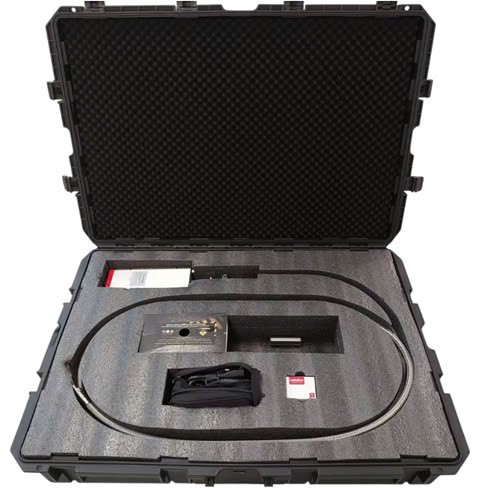 |
| Figure 1: TempVision 1000 system. |
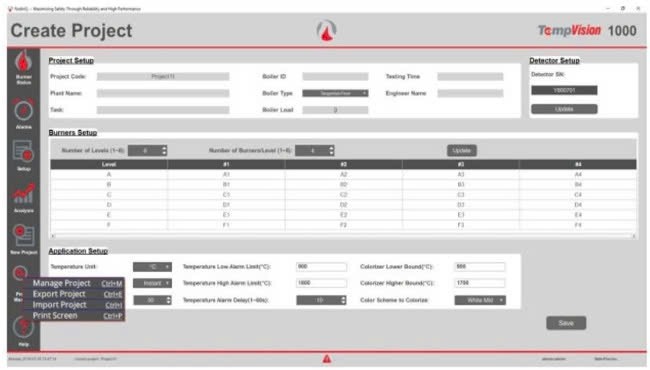 |
| Figure 2: Illustration of the dedicated software interface. |
The TEMPVISION 1000 device features a wide temperature measurement range of 850°C to 1900°C, 1% accuracy class, and a wide field of view, enabling fast and precise flame temperature measurements at each observation port corresponding to individual fuel burners. This system performs real-time furnace temperature monitoring through advanced flame scanning and imaging technology.
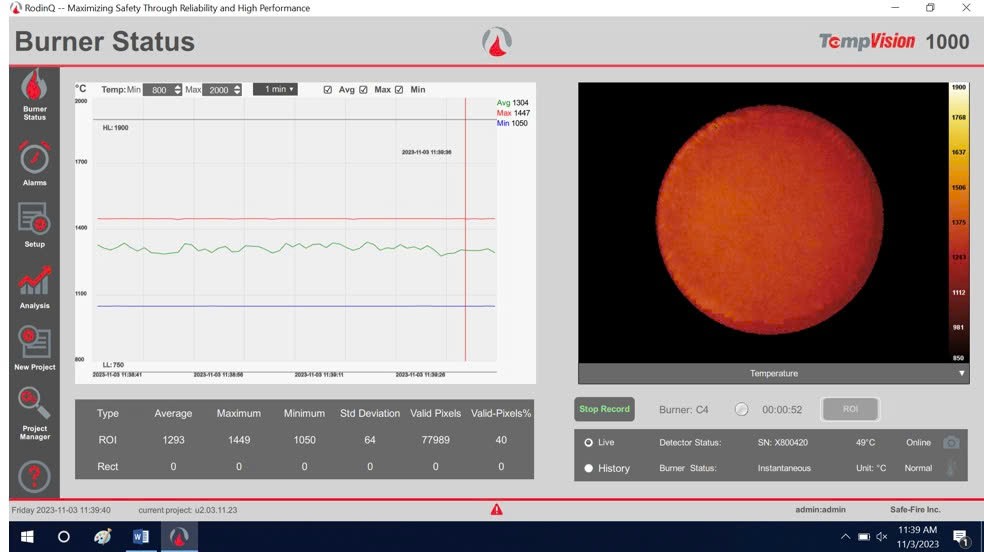 |
| Figure 3: Software display illustrating the measurement results at an observation port using the TempVision 1000 system. |
2. TempVision 5000 (TempVision5000 Online Temperature Profile Measurement System – T5000) is designed to perform continuous, real-time measurement of burner flame temperature profiles within the combustion zone of industrial boilers or coal-fired power plant furnaces. The system can be flexibly configured to suit a wide variety of boiler and furnace types through the integration of dedicated TempVision thermal sensors with a central data processing and communication unit.
This system provides boiler operators with accurate and immediate temperature data from the combustion zone, supporting visual monitoring of temperature distribution, temperature fluctuation trends, flame dynamics, and overall thermal behavior inside the furnace.
The large volume of data collected by the TempVision system forms the basis for combustion engineers to carry out Combustion Tuning, which includes:
-
Balancing primary air and fuel flow under both cold and hot operating conditions.
-
Adjusting secondary air flow and its distribution.
-
Optimizing the burner swing angle.
-
Tuning the furnace exit oxygen (O₂) content.
These adjustments yield several operational benefits:
-
Improved combustion and thermal efficiency of the boiler.
-
Reduced coal consumption.
-
Minimized slagging and fouling.
-
Lower risk of localized overheating and incomplete combustion zones, which in turn reduces the generation of NOₓ, CO, and other pollutants.
The TempVision 5000 system functions as a big data platform for combustion optimization and is considered a key component of intelligent power plant solutions.
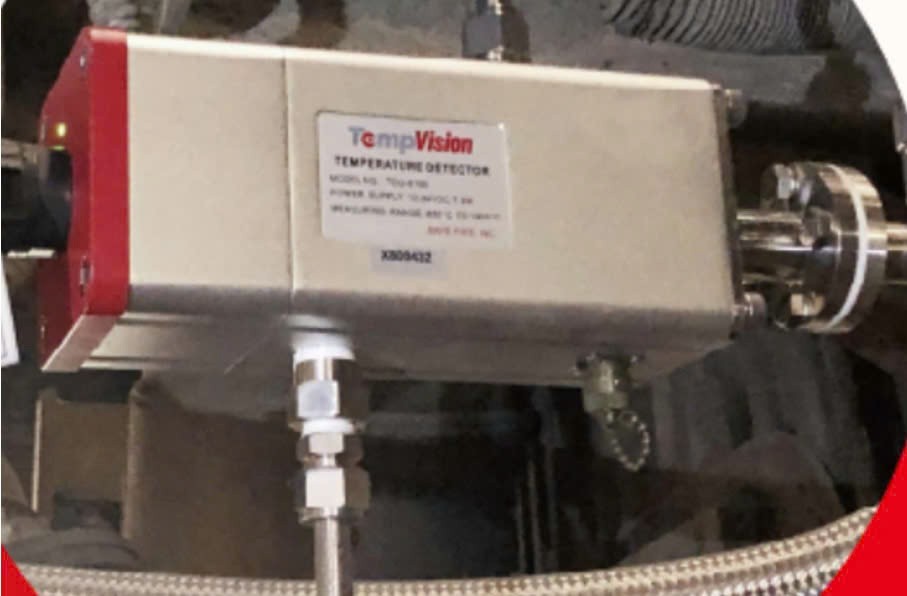 |
| Figure 4: Illustration of the temperature detector used in the TempVision 5000 system. |
 |
| Figure 5: Simplified schematic of the TempVision 5000 (T5000) system:1 – Temperature sensor, 2 – Air supply box, 3 – Function unit, 4 – Local operation cabin, 5 – Main control cabin, 6 – Operator control station. |
The T5000 system can be installed according to each level (or layer) of the fuel burner arrangement—typically with four burners per level. For a standard coal-fired boiler equipped with 24 fuel burners, up to 4 × 6 = 24 temperature sensors can be deployed throughout the furnace. This enables boiler operators to monitor the real-time flame combustion process across the entire interior of the furnace, ensuring comprehensive thermal visibility and control.
III. Application of TempVision 1000 at Vung Ang 1 Thermal Power Plant [2]
Recognizing the importance of real-time flame monitoring to improve combustion efficiency, the operations team at Vung Ang 1 Thermal Power Plant (2 × 600 MW capacity) collaborated with experts from Safe-Fire Inc. to conduct an experimental deployment of the TempVision 1000 system on Boiler Units No. 1 and 2 between November 12, 2019 and January 17, 2020.
By observing the flame temperature distribution at a selected burner layer, operators were able to identify abnormal high- and low-temperature zones within the furnace. Based on this, they made adjustments to fuel distribution, primary and secondary air supply, and carried out aerodynamic and thermodynamic balancing across each burner to align flame temperatures to a consistent target value. These flame tuning efforts resulted in more uniform combustion and heat transfer around the burner belt region of the furnace. The following positive outcomes were recorded:
-
More uniform thermal distribution within the furnace improved heat absorption by the steam-generating tube banks, which in turn reduced the formation of large slag deposits that typically impair boiler reliability and performance.
-
Improved air-fuel mixing from more consistent aerodynamic conditions enhanced combustion quality, reducing unburnt carbon content. Loss on ignition (LOI) in fly ash and bottom ash stabilized at 4–5%, compared to 9–10% before optimization.
Reduced high-temperature zones led to fewer slagging issues. Large, sticky slags that risked damaging the cold slag hopper tubes were significantly minimized. Slag behavior improved, and the formation of heavy slag deposits at furnace corners was greatly reduced.
Summary of Experimental Results at Vung Ang 1:
Boiler Efficiency Performance (*):
-
Unburnt carbon in fly ash decreased from 6.23% to 5.25%; in bottom ash, from 5.97% to 4.01%. Correspondingly, combustion losses dropped from 2.88% to 2.31%, and overall thermal losses decreased from 11.02% to 10.3%. These improvements raised boiler thermal efficiency from 88.98% to 89.7%.
-
As of August 2020, coal savings were estimated at 20,000 tons (compared to 12,500 tons in 2019), exceeding the previous year’s savings by 60% (based on monitoring data and 2020 technical-economic benchmarks). The estimated cost savings amounted to approximately VND 44 billion, based on the 2020 coal procurement price.
-
The average heat rate of the plant (as of August 2020) improved by 168 kJ/kWh compared to 2019.
-
The measured average heat rate was also 353 kJ/kWh lower than the PPA (Power Purchase Agreement) contracted heat rate.
-
Boiler efficiency improved by 0.5% to 1%, based on operational data during the actual performance period.
* Boiler efficiency evaluation before and after tuning was conducted by ASME PTC 4 – Fired Steam Generators Performance Test Code, issued by the American Society of Mechanical Engineers (ASME).
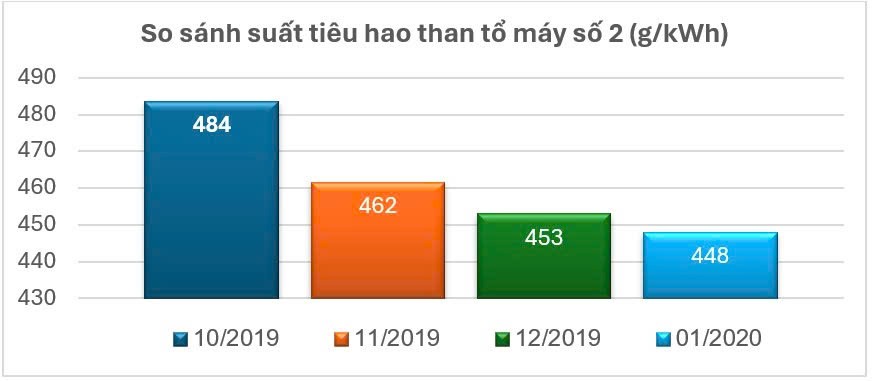 |
| Figure 6: Comparison of coal consumption rates before and after flame tuning on Boiler No. 2 using the TempVision 1000 system. |
About Slagging:
The implementation of TempVision 1000 significantly reduced incidents of steam tube rupture in the cold slag hopper area caused by falling slag. Prior to tuning (from May 28, 2019 to January 26, 2020), there were five recorded cases of ruptured steam tubes in this area. However, since March 2020, no such failures have occurred due to falling slag. This has eliminated the need for three costly boiler restarts, each estimated at VND 7 billion, following unscheduled shutdowns for repairs.
Additionally, there was a notable change in slag formation characteristics. After tuning, slag deposits tended to become more porous and lighter, as illustrated in Figure 7.
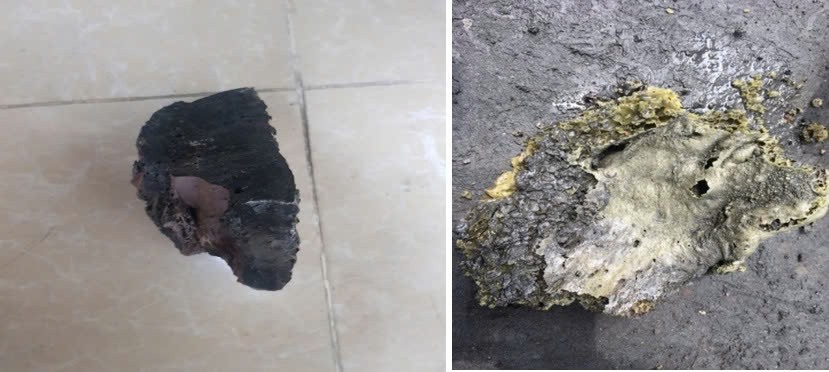 |
| Figure 7: Images of slag deposits before and after flame tuning on Boiler No. 2 at Vung Ang 1 Thermal Power Plant. |
IV. Application of TempVision 5000 at Ratu Coal-Fired Power Plant, Indonesia [3]
The PLTU Pelabuhan Ratu Coal-Fired Power Plant in Indonesia is owned and operated by PT Perusahaan Listrik Negara (PLN), the state electricity corporation of Indonesia. The plant has an installed capacity of 3 × 300 MW, and its boilers were supplied by Shanghai Electric Corporation (China).
In 2019, the Ratu power plant purchased and deployed Safe-Fire’s TempVision 1000 handheld temperature monitoring system. In 2021, the plant was honored with the annual Subroto Award by the Indonesian Ministry of Energy and Mineral Resources (ESDM), in recognition of its energy efficiency achievements. These improvements were attributed in part to boiler efficiency gains realized through combustion tuning, based on accurate temperature profile data provided by the TempVision 1000 device.
In 2024, the collaboration between PLTU Pelabuhan Ratu and Safe-Fire continued with a new project scope involving the installation of the TempVision 5000 online temperature measurement system at Level B of Boiler Unit No. 3. The T5000 system, consisting of four real-time thermal sensors, was connected to a suite of data transmission units, display modules, and control room interfaces.
From October to December 2024, plant engineers at Ratu carried out flame monitoring and tuning operations using the TempVision 5000 system at the selected level, enabling them to optimize combustion performance based on live temperature profile data.
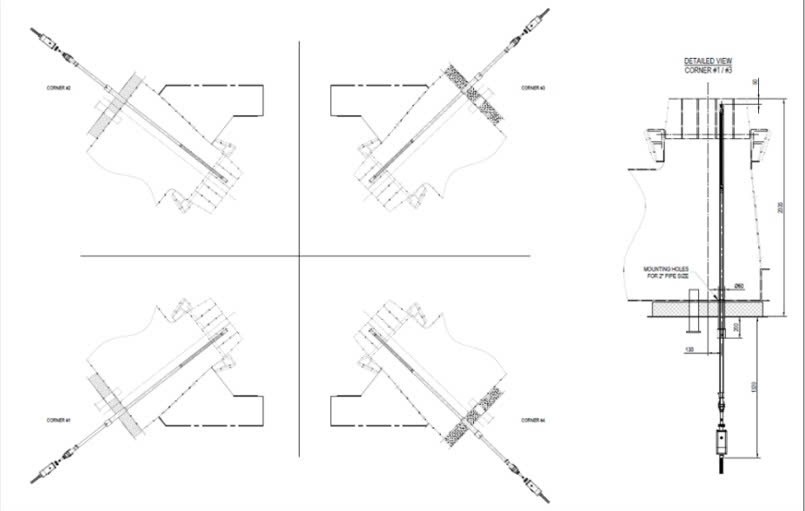 |
| Figure 8: Layout diagram of the four TempVision 5000 detectors installed at Level B of Boiler No. 3 at the Ratu Power Plant. |
 |
| Figure 9: Images of the combustion zones in Boiler No. 3 at the Ratu Power Plant before (left) and after (right) flame tuning based on data provided by the TempVision 5000 software. |
Using the data obtained from the T5000 system, the operating engineers adjusted the combustion process in Boiler No. 3. The evaluation of boiler performance before and after the application of the TempVision 5000 system was conducted by the American National Standard ASME PTC 4-1998.
The results were as follows:
-
From January to August 2024, the boiler efficiency of Unit No. 3 was 81.29%.
-
From October to December 2024, after implementing T5000-based combustion tuning, the efficiency increased to 82.73%.
-
This represents a 1.44% improvement in boiler efficiency.
V. Conclusion
According to the representative of Safe-Fire Inc. in Vietnam, the company guarantees that the TempVision 5000 system will yield at least a 1% annual coal savings for each boiler where it is implemented.
For a typical coal-fired power plant with a capacity of 2 × 600 MW and an estimated 6,000 full load hours per year, using the coal consumption data of Vung Ang 1 Thermal Power Plant prior to deploying the TempVision 1000 system, the annual coal consumption is approximately 3.484 million tons. Based on the current average imported coal price of USD 90 per ton (for sub-bituminous coal 6A, calorific value ~4,850 kcal/kg), a 1% reduction in coal usage equates to 34,484 tons saved per year, which translates to VND 81.5 billion in cost savings (at an exchange rate of VND 26,000/USD).
This does not include the additional savings from avoiding 2–3 boiler restarts per year due to slag-induced tube ruptures—each restart costing around VND 7 billion—as well as savings in various related operational costs.
The overview of TempVision Combustion technology, developed and patented by Safe-Fire Inc., and its recent applications at Vung Ang 1 Power Plant in Vietnam and PLTU Pelabuhan Ratu in Indonesia, clearly demonstrates its value. This is a modern, innovative technology with proven results and patented recognition, offering not only energy savings and operational cost reductions for power plant boilers, but also potential applications across hundreds of industrial boilers and cement kilns in Vietnam.
Moreover, fuel savings directly contribute to emission reductions, including pollutants such as SOₓ, NOₓ, and especially greenhouse gas CO₂. TempVision technology is expected to become a key enabler on Vietnam’s pathway to carbon neutrality, both in the short and long term.
Nguyen Anh Tuan (A)
The Scientific Advisory Board of the Vietnam Energy Journal.
References:
[1] Vietnam Journal of Thermal Energy, Issue No. 12 (2022) – Study on the Impact of Flame Temperature Tuning at Burners on Efficiency and Operational Quality of Pulverized Coal Boilers with W-shaped Flame Configuration
Available at: https://vjol.info.vn/index.php/HKHKTNHIET/issue/view/7046
[2] U.S. Patent and Trademark Office – TempVision Technology Patent
Access at: https://ppubs.uspto.gov/pubwebapp/
[3] Download link – Official confirmation letter from PT PLN (Perusahaan Listrik Negara), the National Electricity Corporation of Indonesia, addressed to Safe-Fire, acknowledging the efficiency improvement of Boiler No. 3 at the Ratu Power Plant following the implementation of the TempVision 5000 system.
Editorial Note
Safe-Fire Inc. is a global company specializing in advanced solutions for flame detection, combustion diagnostics, and ignition systems for industrial and utility-scale boilers.
Headquarters (USA):
-
Address: 5027 Irwindale Ave. Suite 300, Irwindale, CA 91706, United States
-
Phone: +1 626 960 3800
-
Email: [email protected]
-
Website: https://www.safe-fire.com
Vietnam Representative:
-
Contact: Mr. Pham Trung Thanh
-
Phone: +84 939 081 183
-
Email: [email protected]
